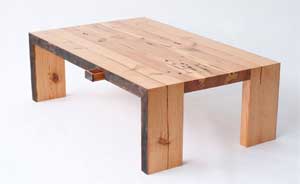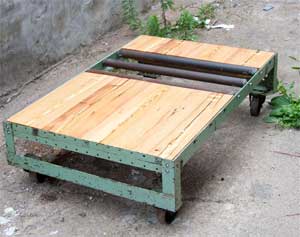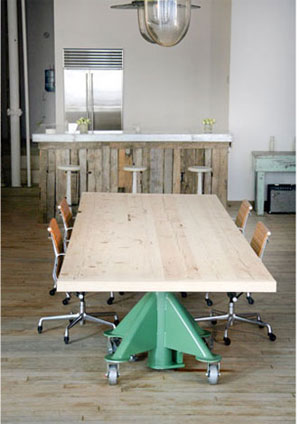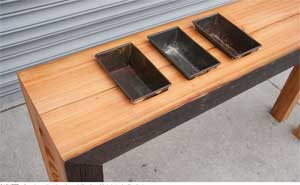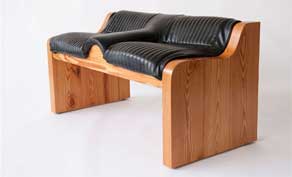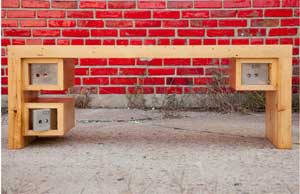
When Jesse Hooker was pursuing an acting career, he realized “it’s important to have a day job to fall back on.” And, since he had high school and college job experience working in wooden boat restoration shops, woodworking seemed a natural fit for the day job.
He spent his days working in boat shops and woodworking shops in New York, and his nights acting and auditioning. Then, “about three years ago, I had an epiphany: what I really loved doing, what I was excited about, all the periodicals and books I was reading — it was all about woodworking.”
One of the appeals of woodworking, Jesse said, is its tangible nature. “At the end of the day, I can see exactly how much work I did. With acting work, it’s more ethereal: you do a show at night, people applaud, then it’s gone — there’s no record of what you did.”
Jesse’s woodworking also contributes to the historical record: his shop is located in an industrial part of Brooklyn, New York, where there are frequent renovations of factories, lofts and so on, resulting in things like wooden beams being thrown out. “I’ll be driving to work, and I’ll stop and find these things, and then they become dining tables,” Jesse said.
He might also find things like a cash register at a surplus shop to build a piece around. There’s a lot of wood and metal to work with, and “a lot of heart pine, some hemlock, a lot of watertower cedar floating around,” Jesse said. The most interesting piece of surplus he ever came across, however, was a rolling factory conveyor belt rack. After asking the person in charge of the renovations if he could have it, “I dragged it about four blocks down the street to the shop, and made a coffee table around it,” Jesse said.
Sometimes, he’ll let a supply of heart pine, or of ipe, or of something else, and just let it sit for a while until “One day, I think, ‘oh, this would make a perfect coffee table.'”
“I’m really into the historic nature of the pieces,” Jesse said. It has an appeal for clients, as well. For instance, “You can have a table, and I can tell you the street address where it came from,” Jesse said. “If you’re having a dinner party and the conversation comes to, ‘That’s a really nice table, where’d you get that?’ you can say, ‘Here’s the guy who made it, and here’s where it came from.’ It’s almost like provenance with a piece of art.”
Of course, this kind of woodworking does present its own challenges, as well. “The de-nailing process is the one thing that separates reclaimed woodworkers from other woodworkers,” Jesse said. “It’s an arduous one- to two-day process before you even get to squaring boards.” Plus, “No matter how hard you look, you will not find all the lath nails and squarehead nails embedded in,” he added.
One of his favorite woods, heart pine — which is the wood he’s made his own dining table out of — also “gums up every blade or bit,” Jesse said. But, Jesse said, “I love the look of heart pine: it’s tight-grained, and when it’s oiled, it settles really nicely.”
And, as he’s spending a couple of days on the de-nailing process, “You really get to know the piece — the grain, the knots; you get to know what might work well where. I’ll often find pieces with hand-cut mortises in them, and I try to keep those in the piece.”
He credits his experience in boat building shops, where he was often reconnecting planks on Chris Crafts and other show boats, with training him to keep as much of the original of a piece in place as possible. “I definitely like the challenge of trying to be the wood doctor, instead of starting over from scratch,” Jesse said.
Of course, another challenge Jesse faces when using reclaimed materials is that, “Once a commodity is exhausted, I can never find it again.” That means that, up until now, his pieces have been one-offs. Recently, however, Jesse has come up with a “Stag Table” plan, with a metal base and tapered legs, which will allow him to use reclaimed materials, but to make multiples of a project.
Customization of each piece will come from the choice of wood type, color and size — whether the piece is a dining table or a coffee table, for instance — “but the leg is always going to be the same. I’m not reinventing the wheel every time,” Jesse said.
“I hope there’s always going to be a supply of material,” Jesse said. “As people are tearing stuff down to build condos or whatever, I’ll be there.”
